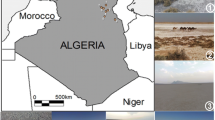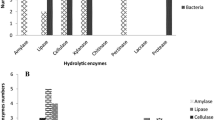Abstract
Screening of bacteria from different areas of Howz Soltan playa, a hypersaline lake in the central desert zone of Iran, led to the isolation of 231 moderately halophilic bacteria, which were able to grow optimally in media with 5–15% of salt, and 49 extremely halophilic microorganisms that required 20–25% of salt for optimal growth. These isolates produced a great variety of extracellular hydrolytic enzymes. A total of 195, 177, 100, 95, 92, 68, 65, 33, and 28 strains produced lipases, amylases, proteases, inulinases, xylanases, cellulases, pullulanases, DNases, and pectinases, respectively. In comparison with gram-negative bacteria, the gram-positive halophilic rods, showed more hydrolytic activities. Several combined activities were showed by some of these isolates. One strain presented 9 hydrolytic activities, 4 strains presented 8 hydrolytic activities, 10 strains presented 7 hydrolytic activities and 29 strains presented 6 hydrolytic activities. No halophilic isolate without hydrolytic activity has been found in this study. According to their phenotypic characteristics and comparative partial 16S rRNA sequence analysis, the halophilic strains were identified as members of the genera: Salicola, Halovibrio, Halomonas, Oceanobacillus, Thalassobacillus, Halobacillus, Virgibacillus, Gracilibacillus, Salinicoccus, and Piscibacillus. Most lipase and DNase producers were members of the genera Gracilibacillus and Halomonas, respectively, whereas most of the isolates able to produce hydrolytic enzymes such as amylase, protease, cellulose (CMCase) and inulinase, belonged to gram-positive genera, like Gracilibacillus, Thalassobacillus, Virgibacillus, and Halobacillus.



Similar content being viewed by others
References
Allais JJ, Kammoun S, Blanc P, Girard C, Baratti JC (1986) Isolation and characterization of bacterial strains with inulinase activity. Appl Environ Microbiol 52:1086–1090
Amoozegar MA, Malekzadeh F, Malik KA (2003) Production of amylase by newly isolated moderate halophile Halobacillus sp. Strain MA-2. J Microbiol Methods 52:353–359. doi:10.1016/S0167-7012(02)00191-4
Amoozegar MA, Schumann P, Hajighasemi M, Fatemi AZ (2008) Salinivibrio proteolyticus sp. nov. a moderately halophilic and proteolytic species from a hypersaline lake in Iran. Int J Syst Evol Microbiol 58:1159–1163. doi:10.1099/ijs.0.65423-0
Birbir M, Ilgaz A (1996) Isolation and identification of bacteria adversely affecting hide and leather quality. J Soc Leather Technol Chem 80:147–153
Felsenstein J (1993) PHYLIP (Phylogeny Inference Package) version 3.5C, Distributed by the author, Department of Genetics University of Washington, Seattle
Felsenstein J (1985) Confidence limits on phylogenies: an approach using bootstrap. Evolution Int J Org Evolution 39:783–791. doi:10.2307/2408678
Gomez J, Steiner W (2004) The biocatalytic potential of extremophiles and extremozymes, extremophiles and extremozymes. Food Technol Biotechnol 2:223–235
Jukes TH, Cantor CR (1969) Evolution of protein molecules. In: Munro HN (ed) Mammalian protein metabolism, vol 3. Academic Press, New York, pp 21–32
Kumar S, Nei M, Dudley J, Tamura K (2004) Mega4: molecular evolutionary genetics analysis mega software version 4.0. Mol Biol Evol 24:1596–1599
Kushner DJ, Kamekura M (1988) In: Rodriguez-Valera F (ed) Physiology of halophilic bacteria, vol 1. CRC Press, Boca Raton, ISBN 0-84934367-4, pp 109–140
Margesin R, Schinner F (2001) Potential of halotolerant and halophilic microorganisms for biotechnology. Extremophiles 5:73–83. doi:10.1007/s007920100184
Martin S, Marquez M, Sanchez-Porro C, Mellado E, Arahal DR, Ventosa A (2003) Marinobacter lipolytic sp. nov. a novel moderate halophile with lipolytic activity. Int J Syst Evol Microbiol 53:1383–1387. doi:10.1099/ijs.0.02528-0
Mellado E, Moore EBR, Nieto JJ, Ventosa A (1996) Analysis of 16S rRNA gene sequences of Vibrio costicola strains: description of Salinivibrio costicola gen. nov., comb. nov. Int J Syst Bacteriol 46:817–821
Mellado ME, Ventosa A (2003) Biotechnological potential of moderately and extremely halophilic microorganisms. In: Barredo JL (ed) Microorganisms for health care, food and enzyme production. Research Signpost, Kerala, pp 233–256
Moreno ML, Mellado E, Garcia MT, Ventosa A (2007) Diversity of extreme halophiles producing hydrolytic enzymes in hypersaline habitats, Halophiles-2007 booklet, pp 59–60
Onishi H, Mori T, Takeuchi S, Tani K, Kobayashi T (1983) Halophilic nuclease of a moderately halophilic Bacillus sp. Production purification and characteristics. Appl Environ Microbiol 45:24–30
Ramos-Comenzana A (1993) Ecology of moderately halophilic bacteria. In: Vreeland RH, Hotchstein LI (eds) The biology of halophilic bacteria. CRC Press, Boca Raton, pp 55–86
Rodriguez-Valera F (ed) (1988) Characteristics and microbial ecology of hypersaline environments. In: Halophilic bacteria, vol 1. CRC Press, Boca Raton, ISBN 0-84934367-4, pp 3–30
Ruben D, Gonzalez E, Arenas C, Vilches EB, De Billerbeck M (1993) Selective procedure for isolating microorganisms producing pullulanase and isoamylase. Biotechnol Tech 7:429–434
Saitou N, Nei M (1987) The neighbor joining method: a new method for reconstructing phylogenetic trees. Mol Biol Evol 4:406–425
Samad MYA, Razak CAN, Salleh AB, Zinwan Yunus WM, Ampon K, Basri M (1989) A plate assay for primary screening of lipase activity. J Microbiol Methods 9:51–56. doi:10.1016/0167-7012(89)90030-4
Sanchez-Porro C, Martin S, Mellado E, Ventosa A (2002) Diversity of moderately halophilic bacteria producing extracellular hydrolytic enzymes. J Appl Microbiol 94:295–300. doi:10.1046/j.1365-2672.2003.01834.x
Sanchez-Porro C, Mellado E, Bertold C, Antranikian G, Ventosa A (2003) Screening and characterization of the protease cp1 produced by the moderately halophilic bacterium pseudoalteromonas sp, strain cp76. Extremophiles 7:221–228
Shahrabi M (1989) Seas and lakes of Iran. Iranian Geography Organization Press, pp 247–259
Smibert RM, Krieg NR (1994) Phenotypic characterization. In: Gerhardt P (ed) Methods for general and molecular bacteriology. American Society for Microbiology, Washington, DC, pp 607–654
Soares Marcia MCN, De Silva R, Gomez E (1999) Screening of bacterial strains for pectinolytic activity: characterization of the polygalacturonase produced by Bacillus sp. Rev Microbiol 30:299–303
Thompson JD, Gibson TJ, Plewniak F, Jeanmougin F, Higgins DJ (1997) The clustral X windows interface: flexible strategies for multiple sequence alignment aided by quality analysis tools. Nucleic Acids Res 24:4876–4882. doi:10.1093/nar/25.24.4876
Ventosa A, Quesada E, Rodriguez-Valera F, Ruiz-Berraguero F, Ramos-Cormenzana A (1982) Numerical taxonomy of moderately halophilic gram-negative rods. J Gen Microbiol 128:1959–1968
Ventosa A, Nieto JJ (1995) Biotechnological applications and potentialities of halophilic microorganisms. World J Microbiol Biotechnol 11:85–94. doi:10.1007/BF00339138
Ventosa A, Nieto JJ, Oren A (1998) Biology of moderately halophilic aerobic bacteria. Microbiol Mol Biol Rev 62:504–544
Ventosa A (2006) Unusual microorganisms from unusual habitats: hypersaline environments. In: Logan NA, Lappin-Scott HM, Oyston PCF (eds) Prokaryotic diversity-mechanism and significance. Cambridge University Press, Cambridge, pp 223–253
Wejse PL, Ingvorsen K (2003) Purification and characterization of two extremely halotolerant xylanase from a novel halophilic bacterium. Extremophiles 7:423–431
Zavaleta AI, Cardenas-Fernandez AM (2007) Diversity of moderately halophilic bacteria producing extracellular hydrolytic enzymes isolated from Pilluana salt brine in Peru. Halophiles-2007 congress booklet, pp 50–51
Zhou XH, Li Z (2004) CMCase activity assay as a method for cellulose adsorption analysis. Enzyme Microbiol Technol 35:455–459
Author information
Authors and Affiliations
Corresponding author
Rights and permissions
About this article
Cite this article
Rohban, R., Amoozegar, M.A. & Ventosa, A. Screening and isolation of halophilic bacteria producing extracellular hydrolyses from Howz Soltan Lake, Iran. J Ind Microbiol Biotechnol 36, 333–340 (2009). https://doi.org/10.1007/s10295-008-0500-0
Received:
Accepted:
Published:
Issue Date:
DOI: https://doi.org/10.1007/s10295-008-0500-0




